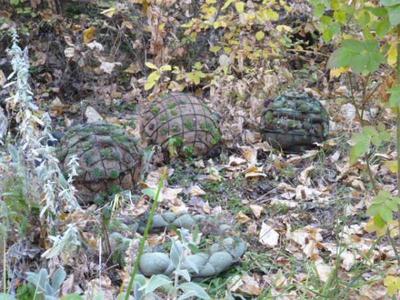
by Jacki
(Grand Forks, B.C. Canada)





Winters coming – how do you prepare for it?
If you have containers filled with hardy succulents, this is an easy one – in most cases, those types of containers already drain really well, as that’s a major requirement for those types of plants.
I usually just place them carefully among perennial plants in my garden beds, and the snow will cover them for protection. I know it sounds counter intuitive, but snow will actually keep them a little bit warmer, and the other property it has is that it prevents temperature swings, which is really crucial for many succulent plants.
I have many driftwood root planters that don’t get any special preparation for winter. They emerge in spring, none the worse for wear. Any that are up off the ground, displayed on a bench for instance, will suffer some die back, and I might have to replace some of the plants in spring. It’s a case of filling in the gaps, or in many of these planters, the existing survivors will grow to fill them in.
I was asked recently what to do in the case of some wedding favor succulents – these were Sempervivum, and the wedding is in December. This takes a bit of prior planning; this was my advice; prevent full dormancy before the wedding date by keeping them cool but under lights in a basement, and then after the big day place them in the garden and cover them with leaves. This will allow them to go into dormancy slowly, because of the protection of the leaves.
Mice can be a problem with succulent crafts such as globes and topiaries. I’ve made hardware cloth (wire mesh with very small holes in) boxes or cylinders to cover them, which works great. You can even fill those with dry leaves to protect them. In areas that get a lot of winter rain, I might even put a board over top to keep some of the moisture out.
I’ve also discovered (to my horror) that plants – even those recommended as totally hardy) will not survive without some kind of protection for the roots. Don’t expect even the hardiest of succulents to live through the winter on your deck or balcony. The only way this might work is to completely immerse the pot into a bucket of leaves, a box of sawdust or other insulation. The roots are the most delicate part of any plant, even a hardy succulent.
Only you know your conditions, but these are a few ideas for successfully overwintering your succulent containers.
Comments for Prepare Your Succulent Containers for Winter
Jan 21, 2013
Thanks so much…
by: Julie
…for the timely advice – now, I can save a ton of money on my succulents for planting in the big containers on my deck. I will most likely still need some special ones, but the kinds of succulents that I will overwinter are the easiest to keep going.
I’ll post some pics of my planters next year.
Oct 11, 2019
Great tips
by: Pauline
It’s October, and instead of just dumping all my hardy succulents out into the garden to survive or not, I’m going to be a lot more pro-active this year. Off to rake some leaves now to protect some of my faves.
Oct 11, 2019
Leaves
by: Jacki Cammidge, Certified Horticulturist
Be careful on your choice of leaves – the large ones like Acer macrophyllum (large leaf maple) are not as good as smaller, crispier types like most oaks, smaller varieties of maple, and beech. The larger ones tend to mat down, smothering instead of protecting.
Also avoid walnut – these contain juglone, which is like a natural herbicide. Many conifers are not recommended, like cedar and juniper. Stick with deciduous leaves.
Use leaves from trees that don’t have seeds, or you’ll be picking out the seedlings in the spring.
Oct 01, 2020
Cloches
by: Richard
Cut the bottom off a large clear-plastic water-cooler bottle, to make an instant cloche that can be put over a decorative planter or individual succulent to keep off the worst of the rain/snow and give it a few degrees of temperature advantage over unprotected plants. The hole in the neck of the bottle allows the plant inside to breathe but could be fitted with a temporary cap or even covered with a plastic bag in really bad or wet weather.
I keep finding these bottles thrown carelessly into hedgerows and ditches. Bringing them home helps to keep the countryside clean.
Oct 24, 2021
Getting ready for winter
by: Sandy
Will straw work as well as leaves for insulation?

